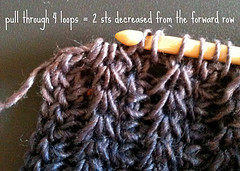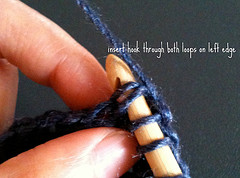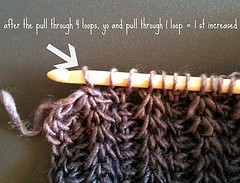I’ve been playing with Tunisian crochet stitches for a while now but never made anything with them. I found that this is a really fascinating technique, and there are infinite ways where you could put a stitch, the possibilities are endless. When I visited my parents last time I found some old pattern cuttings with black and white photos, the quality of the pictures are not brilliant and there’s no information about the stitches. But I was intrigued by this stitch...
After a dozen or so false starts, I think I finally got it sussed. When we start learning to knit or crochet, the first thing we make is most likely to be a scarf, so I’ll start by making a scarf. As one of my New Year’s resolutions is to make something in Tunisian crochet in 2011, I’m going to call it Tunisian Resolution Scarf.
Normally I like to crochet from charts, but I don’t know how to make Tunisian crochet charts. And because I’m not sure I’ll be clear with my instructions, I thought I’d use photo guides to help me. You will find the photo guides after the instructions.
The pattern is based on a 4-stitch repeats + 1. Mine has five pattern repeats, because I don't like wide scarves. To make the scarf wider or narrower you simply add or take away 4 stitches. Also you need 1 extra stitch on each end for the edges. To calculate how many stitches you need use this formula: #repeats x 4 + 1 + 2. Mine has 5 repeats so I started with 23 stitches.
On the return row, you will be asked to pull through 4 loops together and this effectively decreases 2 stitches, to compensate you will be making an increase on either side of this action. Hopefully this will make sense once you have read through the instructions and seen the photos, so please bear with me for now :-)
What you will need:
For my scarf, I used a DK weight yarn from my stash, it’s the leftover from my Not So Short Jacket. I used a 6mm Tunisian crochet hook to get a better drape. My scarf used 2 skeins about 320 meters. Of course you can use any weight yarn and hook, but I would recommend thicker yarn and large hooks for ease of manipulation and speed. :-)
If you are not familiar with Tunisian crochet there are tons of information available online. I like ChezCrochet which is a treasure trove on this technique, if you are after video tutorials you can check out CrochetKim on Youtube.
Some terminologies used in this pattern: (some are made up by myself)
- ch : chain
- lp: loop
- st: stitch
- tss: Tunisian simple stitch
- tfs: Tunisian full stitch (or plain stitch)
- ttt: this means “pick up loop through top thread”, I don’t know what this stitch is called, it’s like pick up loop through the back bump on a chain, but here it’s through the top thread between two vertical bars - please see photos below, it may make better sense.
- yo: yarn over
- yop: yarn over and pull through loop
- p2tog: pull through 2 loops together
- p4tog: pull through 4 loops together
- FR: forward row
- RR: return row (yo, *yo & p2tog* repeat between * * till end, 1 loop remain)
Instructions:
Foundation row: Ch 22 23, pick up lp in 2nd ch from hook through the back bump, and in each of the back bumps across; 23 loops. (I picked up loops in alternate directions, i.e. inserting the hook from front to back, then from back to front in the next bump, so the edge doesn’t curl so much.)
Foundation RR: work as normal back to the right, 1 lp remain.
Set up FR: *tss in the next st, tfs, ttt, tfs*, repeat * * across to the left until 2 st left, tss in the next st, pick up lp through both lps on the end of left edge. 5 repeats, 23 lps.
Set up RR: yop, * yo and p2tog, yop, yo and p4tog, yop *, repeat * *across back to the right until 2 st left, yo and p2tog twice. 5 repeats, 1 lp remain.
FR: *tss in the next st, tfs through the gap, ttt on top of the p4tog, tfs through the gap*, repeat * *across to the left until 2 st left, tss in the next st, pick up lp through both lps on the end of left edge. 5 repeats, 23 lps.
RR: same as Set up RR.
Repeat the FR and RR until you have the length you want, or you run out of yarn or got bored. Oh, in case you need to join in a new skein as I needed to, I joined at the end of a return row where there were only 2 loops left, then p2tog with the new yarn, leaving a 4 inch tail. Then I did a half square knot and wove in the ends separately. I found that the backside of this stitch pattern is perfect for weaving in ends. A bonus! :-)
End row: just do a FR across to the left (23 lps) and do the return row as normal, i.e. without increase or decrease. Fasten off and weave in ends.
My finished scarf measures 178cm x 12.5cm or 70 in x 5 in. I found that my stitches tend to lean to the right, not quite sure how to counter this yet. I tried to loosen up a bit as I work across to the left, this helped somewhat. Also, overall you need to keep the tensions loose, or I prefer to say "keep the stitches relaxed". But do give the initial loop a little tug before you start a new row so that the right edge is not too loose.
Now I will include some photos I took along the way, hopefully they'll make sense to you. If not, I am happy to answer any questions and will do my best to clear things up for you :-)
 |
| *Notice the gaps among the stitches, that's caused by the yops (increases) |

* When you do p4tog, the 1st loop is from the yop (the increased st) and the other three loops are the (tfs, ttt, tfs) from the forward row. This will result in the 3 stitches become 1. That's why you need to do yop before and after the p4tog so that you still maintain the stitch count. Gosh it sounds so confusing, hope I haven't lost you completely!
* After the set up row, you need to do the tfs through the gaps between the stitches.
* for ttt after the set up row
* If you hold the left edge towards you, you should see the edge looking like slipped stitches that have two bars/loops

* To make a smoother edge on the left, you need to insert the hook through both loops/bars on the left edge for the last stitch on the forward row.
I hope these all make sense to you. The best way is to grab some yarn and a hook and start doing it, it is not a complicated pattern. Once you get pass the set up row, all you have to do is to repeat the same thing over and over again. If you're like me that your mind keeps wondering off in all directions other than the matter at hand, you might find missed stitches here and there, but the good thing is you can usually catch it on the return row so even if you have to frog it's never going to be too many stitches.
It is actually quite amazing how fast this worked up, and the fabric is not rigid at all. Frankly I am quite pleased with myself, and I think it turned out really nice. I hope you will enjoy it as much as I did. :-)
p.s. I'm sorry about the font sizes going up and down, I tried to fixed it but it didn't work.








This looks like so much fun-- and what a great looking scarf! I have been meaning to devote some time to Tunisian; maybe this is my chance ;)) Thanks for a great post!!
ReplyDeleteThanks for sharing this! I used a variation on this stitch pattern for a blanket in my book, Tunisian Crochet: The Look of Knitting with the Ease of Crocheting, and in my Oceanside Dunes Shawl (available via Ravelry).
ReplyDeleteI hope you get a lot of people interested in Tunisian crochet--it is really fun, and creates a whole different look to fabric. If your blog readers are interested, they can join me on FB at Sharon Silverman Contemporary Crochet. Thanks again for advancing the craft of Tunisian crochet!
Wow, this is beautiful. I was looking for a Tunisian stitch to make a project bag with, and this is perfect to do something really beautiful with. Thanks so much for sharing.
ReplyDeletegorgeous gorgeous, and the pattern is unisex and versatile!
ReplyDeleteI'm new to tunisian crochet and have a quick question. I chain 22 and do a foundation row but still only end up with 22 loops but, you instructions say I should have 23 loops. What am I doing wrong?
ReplyDeleteHi, I am SO SO sorry for not having replied sooner, the truth is I am such a terrible blogger and last year I had been super busy with a lot of distractions, please forgive this sloppy blogger, I wasn't being rude, honest!
DeleteAnyway, when you chain 22 there should be 22 chains + the loop on the hook; then when you do the foundation row (i.e. picking up loops) you should pick up 22 loops and with the loop that's already on the hook there should be 23 altogether. Does that make sense?
Thank you for posting this! I do believe this has become my favorite tunisian crochet stitch.
ReplyDeleteHi, the scarf is beautiful! I've been playing around with tunisian but haven't done a project yet...because I dislike the curl that my crochet makes.
ReplyDeleteThis scarf looks to not curl at all, and my 2012 resolution is, like yours was, to make a project with tunisian.
Yea! Thanks for putting this out for us to view and learn! Hope it turns out as pretty as yours!
Kelly
Hi Kelly,
DeleteLike you I didn't like the curl from many tunisian crochet patterns, I found that with a combination of large hook and alternating the direction when picking up loops for the set up row you can manage the curl better. I'm sure yours will turn out beautifully. Good luck!
Cathy
Adding fringe to the ends helps eliminate the curl as well. If you're using natural fibers, blocking will take care of the curl without having to do special stitches.
DeleteHi, I am new to Tunisian crochet, and I am attempting to follow this pattern. However, the link to ChezCrochet is not working and I can not find a definition of the "Tunisian Full Stitch." Does it go by another name elsewhere?
ReplyDeleteHere's a link to the TFS. The link says simple-stitch, but it is, in fact, the full stitch.
Deletehttp://tuncro.blogspot.com/2010/12/tunisian-simple-stitch.html
Basically, you're putting your hook through the space under the chain to the left of the vertical bar. HTH
Thank you Melissa H. for the link and info, I was having trouble finding it as well.
ReplyDeleteI'm still not very skilled at blogging, please excuse my inadequacy.
Hello, I am also very new to Tunisian crochet, and I also have a question about this project. I don't need ANOTHER scarf...lol, so I thought I would make a dishcloth. According to you instructions, you say that if I want to make the project wider or narrower, all I have to do is add/subtract 4 chains and then add the +1 and the +2. I added 8 and then the 1 and the 2, to make a total of 32. My problem starts at the end of the "set up" RR because I am not at the same place when I get to the last 2 stitches. On yours, you end with a "p4tog, yop" and then stt at the last 2; I end with "p2tog, yop" and then the last 2 stt's at the end. So, when I start the first FR; I can't work it as written and I end up with 33 loops on my hook.
ReplyDeleteI hope you get what I am trying to say...lol I don't know where my extra loop is coming from, or how to go forward on the project. I hope you can help. Thanks!
Hi Laura, thanks for showing interest in my pattern, it's been two years since I touched it so I'll need to refresh my own memory. So please bear with me until I go through my notes before answering your question, I'll get back to you as soon as I can :)
DeleteCathy
Thanks so much! I have started another project that might take me a little bit to finish, so don't feel pressured to rush. I do know that I will soon get tired of it and will want to take this one up again, so I do appreciate your help!
DeleteI think I found out where the confusion lies... when I initially did it, I picked up stitch from the chain immediately from the hook instead of "2nd chain from hook". So I've amended it to Ch23 to start.
DeleteTo answer your question, my starting number of chains have already allowed for the extra stitches required for pattern repeats and selvages, therefore you only need to add/subtract 4 stitches. For example, mine is a 5 repeats, to get a 8 repeats you need to add 3x4=12 stitches to my Ch23 start, i.e. Ch35.
Or, to calculate from scratch, use the formula #repeat x4+1+2, i.e., 8x4+1+2=35.
Hope this helps :)
Hahaha, I think I may have to read this a few times to fully understand...but I'll try again. My husband absolutely can not fathom how I can read any crochet pattern...lol I'll get it in the end!
DeleteThanks again for going through all that work!!
What a lovely looking scarf ! I was browsing through Tunisian patterns on Ravelry, and this scarf got and just held my attention. I am now off to dig into my stash for some yarn, and.....I better unpack my new 5mm afghan hook first !!!!
ReplyDeleteCongratulations once again, and a big thank you for keeping it a free pattern, God bless !
Thank you! I hope you enjoy it :-)
DeleteThank you for this pattern! I've been playing with Tunisian crochet off and on for a while but never completed a project before. If you'd like to see it, I made in in pink camo yarn and it's pictured here: https://www.facebook.com/photo.php?fbid=555974784456782&set=pcb.555974801123447&type=1&theater
ReplyDeleteThanks for the link to your finished scarf, it's always nice to see what other people have made with your pattern. Yours is very pretty, I like the colour variations :-)
ReplyDeleteI love this pattern! It works up so much more flexible than other crochet scarves I have made. I have made about a dozen already for Christmas presents. I'm so glad I found it. Thanks for sharing. :)
ReplyDeleteBeautiful pattern! I'm using your pattern to make my first real Tunisian item, a scarf using Caron Simply Soft in a lovely yellow. I've already made a hat with this yarn. I made a "crysanthemum" as a decoration for the hat, so I'm thinking of adding a Curly-Q fringe that would coordinate well with the flower. The curls are made by making a chain, then 2 single-crochet in each stitch. I can't wait to wear the set!
ReplyDeleteI am a knitter...know how to crochet...but it was almost too free for me...with knitting I always knew where I was at...I either had the right amount of stitches or not...then this evening I discovered Tunisian crochet...The Best of Both Worlds!! Specific number of stitches and one needle...simple yet fascinating patterns can result!!...and then I discovered this pattern...thank you, thank you, I feel like I am already a pro!
ReplyDeleteI'm glad you are enjoying it, it is rather addictive this Tunisian crochet :)
DeleteHow much yardage did you use?
ReplyDeleteI used 320 meters, not sure about the yards, probably in the region of 340-350 yards.
DeleteThis comment has been removed by the author.
ReplyDeleteHey Cathy, absolutely love this scarf! What yarn did you use exactly? I love the variegation in colors in it. Thanks!
ReplyDeleteI wish you had a video!!
ReplyDeleteLove the pattern and your helpful instructions. Your suggestion to alternate front and back loop entry on the starting chain is great. No curling! Thanks
ReplyDeleteThis is a gorgeous stitch I like it very much but I don't know how to do Tunisian crochet so please can you tell me the name of this stitch maybe I can find a tutorial to help me doing it
ReplyDeleteCool stitch! I have been doing the tunisian Kiln stitch for for years and never knew there was another one similar to it. I love this!
ReplyDeleteThank you so much for offering this pattern! I used it to make a green and brown striped buttoned cowl. Your directions made perfect sense to me and it was a true joy to stitch, such a soothing and meditative rhythm but changes just often enough that it doesn’t get tedious. It stitches up beautifully. Thanks again!
ReplyDelete